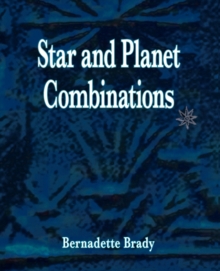This is the long awaited follow-up to Astrolocality Astrology – in which the author starts with the history of locality astrology, telling its story from ancient Babylonia to modern times. He then introduces essential works from contemporary astrologers who are utilising locality techniques today. This is a brilliant opportunity to learn from notable astrologers like: Bernadette Brady, Kathryn Cassidy, Faye Cossar, Donna Cunningham, Robert Currey, Dennis Flaherty, Arielle Guttman, A.Tad Mann, Chris McRae, David Meadows, Dale O’Brien, Angel Thompson and Maya White.
An eBook version is available through the usual online sellers: iBooks, Nook, Googlebooks and Amazon
See also Astrolocality Astrology: A Guide to What it is and How to use it.
Martin Davis
In the course of his work as an engineer, business consultant and sportsman, Martin Davis travelled widely and lived in many different countries. He w...
Show more
When the ancients first started comparing the heavens with human fate, they were faced with the problem of mapping a vast array of variables. Not only were the planets obvious indicators, but so too were the stars, especially the brightest, first magnitude stars. While the planets moved within the band of space we now call the ecliptic (marked by the Sun's apparent path around the earth), the stars were positioned all over the sky. The Greeks, faced with the enormous complexity of this mapping task, invented the modern horoscope, which narrowed the interpretive field to just the ecliptic. Nowadays, when we think of astrology and mapping, the most common technique that pops up is Astro*Carto*Graphy, which is one of the primary topics of discussion in From Here to There, An Astrologer's Guide to Astromapping. Edited by Martin Davis, this comprehensive guide to the astrology of location chronicles the rapid development of this growth industry. The advent of the computer age has reduced the complex calculations and storage of data to mere clicks of a mouse, so that nowadays no one need fear that a miscalculation will throw off the entire interpretive process. Martin Davis has assembled a collection of essays by experts in location astrology, and they are arranged in order of their development, as Davis describes in Chapter 1. Arielle Guttman writes about Jim Lewis and ACG maps in Chapter 2, while Davis explains what one can do with one's computer in Chapter 3. This includes investigating relocation – a favorite past time of professional and amateur astrologers – plus an introduction to Local Space maps, which was the next locality tool that became available after the ACG maps. ACG and LS maps can be used in tandem, and Davis uses several illustrations to show how this works, including his own experience in the 1972 Olympics, which he participated in as a member of the U.S. fencing team. These maps can also be used for synastry, rectification, and tracking various mundane astrology events. In Chapter 4, written by Robert Currey, we see how ACG maps tell a remarkable story about George W. Bush's career. For example, President Bush missed the boat after the Hurricane Katrina disaster in New Orleans. This locale shows that Bush's Neptune IC line runs through New Orleans, and so he naturally felt helpless and pathetic in the wake of this disaster. In contrast, Bush's Pluto Ascendant line runs through New York, where he was more inspiring as he addressed rescue workers at Ground Zero following the 9/11 incident. The next few chapters are written by Maya White, Angle Thompson, A.T. Mann, and Chris McRae, with each sharing their personal experiences and proposed lines of inquiry within the field of location astrology. In my view, Chapter 9, written by Donna Cunningham, is one of the clearest, most practical, and most inspirational chapters in this book. Titled "Would Relocation Change Your Life?", this section is a concise "how-to" guide to what astrological factors you should consider when moving to a new location. It's perfect for budding astrologers who want to add this kind of explorative technique to their analytical tool kits. Cunningham emphasizes the OPP profile, which is the Outer Planet Person. She rhetorically asks that if the outer planets represent an individual's genius, should not he or she move to a place where the prominent outer planet is angular? Then the contribution becomes much more accessible. The answer is not as self-evident as it might seem, however, and you'll have to read this chapter to find out why. Chapters 10 and 11 are written by Dennis Flaherty and Kathryn Cassidy, and then we come to another one of my favorite chapters, written by Bernadette Brady. While many of the chapters in AstroMapping were previously published (mostly in The Mountain Astrologer), Brady's chapter on “Presidential Inaugurations” is new and original – and it's quite complex; it's something that beckons as a future field of inquiry. Brady looks at the whole sky to track the influence of the stars by their actual latitude. This technique is something the ancient Greeks thought about, but abandoned because they didn't have the computers to track everything in the heavens. Concluding chapters were written by David Meadows, Faye Cossar, Dale O'Brien, and Arielle Guttman, again, with each author presenting his or her take on what astromapping can add to our current understanding of astrology. Bottom line: if you are interested in astrology, and have an astrology software program, you'll benefit greatly from studying the material in this book. Martin Davis has done an excellent job in bringing the experts together under one cover, and organizing the material in such a way that you learn the new material as astrologers in general learned new ways of using locational astrology. It's the evolution of astrology which continues to grow in tandem with the growth of computers.
Chris Lorenz - Dell Horoscope

 Art of Forecasting using Solar Returns
Art of Forecasting using Solar Returns 


